Uncovering Urban Green Space (Dis)Investment Through Cultural Ecosystem Service Potential: A Case Study of Szeged, Hungary
Abstract
1. Introduction
2. Potential Cultural Ecosystem Services as Investment Indicators
3. Materials and Methods
4. Results
4.1. Clustering Based on the Potential Cultural Ecosystem Services Values
4.2. Understanding the Investment Differences of Urban Green Spaces
4.3. The Power of Bottom-Up Initiatives on an Example of Informal Greenspace
5. Discussion and Conclusions
Author Contributions
Funding
Data Availability Statement
Conflicts of Interest
Correction Statement
Abbreviations
| CESs | Cultural ecosystem services |
| ESs | Ecosystem services |
| GIS | Geographic information system |
| MEA | Millennium Ecosystem Assessment |
| UGS | Urban green space |
Appendix A
| Dimension | Name |
|---|---|
| Activities performed | Sport activities |
| Table games | |
| Theatres activities | |
| Civic meetings, festivals, or concerts | |
| Traditional fairs | |
| Religious gatherings | |
| Environmental education activities | |
| Environmental quality | Surrounding area |
| Signs of vandalism | |
| Heritage or artistic elements | |
| Paths | |
| Bike paths | |
| Grove density | |
| Shaded spaces | |
| Urban furniture maintenance | |
| Green infrastructure maintenance | |
| Cleaning | |
| Blue spaces | |
| Facilities | Centres or environmental education activities |
| Playgrounds | |
| Car park or nearby parking | |
| Public transport | |
| Leisure spaces | |
| Containers for animal waste | |
| Water sources for animals | |
| Water sources for humans | |
| Cultural and/or recreational equipment | |
| Cafes/bars/restaurants | |
| Public toilets | |
| Accessibility for people with disabilities and/or reduced mobility | |
| Security | Visibility to the streets that surround the green space |
| Visibility to the houses that surround the green space | |
| Areas of little visualization | |
| Adequate infrastructure for physical/sports activity | |
| Lighting | |
| Vigilance |
| Category | Variable |
|---|---|
| General data | Name of the sample area: |
| Date and time of the observation: | |
| Type of the weather: sunny/windy/cloudy/rainy | |
| Temperature (°C): | |
| Activities performed by the visitors | Number of visitors performing physical activities: |
| Number of visitors performing social activities: | |
| Number of visitors performing nature-related activities: | |
| Number of visitors attending alone: | |
| Number of visitors attending as part of a group of people: | |
| Demographics | Number of female visitors: |
| Number of male visitors: | |
| Number of children visitors: | |
| Number of young adult visitors: | |
| Number of middle-aged adult visitors: | |
| Number of late middle-aged adult visitors: | |
| Number of elderly visitors: |
Appendix B
| Sample Areas | Based on the 36 Variables Aggregated into 4 Categories, with Ward’s Hierarchical Method | Based on 36 Variables, with Ward’s Hierarchical Clustering | Based on 7 Principal Components, with Ward’s Hierarchical Method | Based on 4 Factors, with Ward’s Hierarchical Method | Based on 4 Factors, with K-Means Method |
|---|---|---|---|---|---|
| Centre/1 | 1 | 4 | 2 | 2 | 4 |
| Centre/2 | 1 | 4 | 2 | 2 | 2 |
| Centre/3 | 1 | 4 | 3 | 1 | 2 |
| Informal/1 | 2 | 1 | 1 | 4 | 3 |
| Informal/2 | 2 | 1 | 1 | 4 | 3 |
| Informal/3 | 2 | 1 | 1 | 4 | 3 |
| Informal/4 | 2 | 1 | 1 | 4 | 3 |
| Informal/5 | 2 | 1 | 1 | 4 | 3 |
| Playground/1 | 3 | 2 | 2 | 2 | 2 |
| Playground/2 | 3 | 2 | 2 | 2 | 4 |
| Playground/3 | 3 | 2 | 2 | 2 | 4 |
| Playground/4 | 3 | 2 | 2 | 2 | 2 |
| Playground/5 | 3 | 2 | 2 | 2 | 2 |
| Playground/6 | 3 | 2 | 3 | 2 | 4 |
| Playground/7 | 3 | 2 | 2 | 1 | 2 |
| Playground/8 | 3 | 2 | 2 | 1 | 2 |
| Park/1 | 4 | 3 | 3 | 3 | 1 |
| Park/2 | 4 | 3 | 3 | 3 | 1 |
| Park/3 | 4 | 3 | 3 | 3 | 1 |
References
- United Nations. 2018 Revision of World Urbanization Prospects. New York, 2018. Available online: https://www.un.org/en/desa/2018-revision-world-urbanization-prospects (accessed on 7 July 2025).
- Lopes, H.S.; Vidal, D.G.; Cherif, N.; Silva, L.; Remoaldo, P.C. Green infrastructure and its influence on urban heat island, heat risk, and air pollution: A case study of Porto (Portugal). J. Environ. Manag. 2025, 376, 124446. [Google Scholar] [CrossRef]
- Gozalo, G.R.; Morillas, J.M.B.; González, D.M. Perceptions and use of urban green spaces on the basis of size. Urban For. Urban Green. 2019, 46, 126470. [Google Scholar] [CrossRef]
- Giles-Corti, B.; Broomhall, M.H.; Knuiman, M.; Collins, C.; Douglas, K.; Ng, K.; Lange, A.; Donovan, R.J. Increasing walking: How important is distance to, attractiveness, and size of public open space? Am. J. Prev. Med. 2005, 28, 169–176. [Google Scholar] [CrossRef]
- Kántor, N.; Unger, J.; Gulyás, Á. Subjective estimations of thermal environment in recreational urban spaces—Part 2: International comparison. Int. J. Biometeorol. 2012, 56, 1089–1101. [Google Scholar] [CrossRef]
- One Health High-Level Expert Panel (OHHLEP); Adisasmito, W.B.; Almuhairi, S.; Behravesh, C.B.; Bilivogui, P.; Bukachi, S.A.; Casas, N.; Becerra, N.C.; Charron, D.F.; Chaudhary, A.; et al. One Health: A new definition for a sustainable and healthy future. PLOS Pathog. 2022, 18, e1010537. [Google Scholar] [CrossRef]
- Bruno, A.; Arnoldi, I.; Barzaghi, B.; Boffi, M.; Casiraghi, M.; Colombo, B.; Di Gennaro, P.; Epis, S.; Facciotti, F.; Ferrari, N.; et al. The One Health approach in urban ecosystem rehabilitation: An evidence-based framework for designing sustainable cities. iScience 2024, 27, 110959. [Google Scholar] [CrossRef]
- Castañeda, N.R.; Pineda-Pinto, M.; Gulsrud, N.M.; Cooper, C.; O’dOnnell, M.; Collier, M. Exploring the restorative capacity of urban green spaces and their biodiversity through an adapted One Health approach: A scoping review. Urban For. Urban Green. 2024, 100, 128489. [Google Scholar] [CrossRef]
- Aronson, M.F.; A Lepczyk, C.; Evans, K.L.; A Goddard, M.; Lerman, S.B.; MacIvor, J.S.; Nilon, C.H.; Vargo, T. Biodiversity in the city: Key challenges for urban green space management. Front. Ecol. Environ. 2017, 15, 189–196. [Google Scholar] [CrossRef]
- Grammatikopoulou, I.; Vačkářová, D. The value of forest ecosystem services: A meta-analysis at the European scale and application to national ecosystem accounting. Ecosyst. Serv. 2021, 48, 101262. [Google Scholar] [CrossRef]
- Pukowiec-Kurda, K. The urban ecosystem services index as a new indicator for sustainable urban planning and human well-being in cities. Ecol. Indic. 2022, 144, 109532. [Google Scholar] [CrossRef]
- Tandarić, N.; Ives, C.D.; Watkins, C. Can we plan for urban cultural ecosystem services? J. Urban Ecol. 2020, 6, juaa016. [Google Scholar] [CrossRef]
- Farkas, J.Z.; Hoyk, E.; de Morais, M.B.; Csomós, G. A systematic review of urban green space research over the last 30 years: A bibliometric analysis. Heliyon 2023, 9, e13406. [Google Scholar] [CrossRef]
- Chen, S.; Wang, Y.; Ni, Z.; Zhang, X.; Xia, B. Benefits of the ecosystem services provided by urban green infrastructures: Differences between perception and measurements. Urban For. Urban Green. 2020, 54, 126774. [Google Scholar] [CrossRef]
- Cheng, X.; Van Damme, S.; Li, L.; Uyttenhove, P. Evaluation of cultural ecosystem services: A review of methods. Ecosyst. Serv. 2019, 37, 100925. [Google Scholar] [CrossRef]
- Dominici, A.; Sacchelli, S. Urban green infrastructure valuation: An economic method for the aesthetic appraisal of hedges. Aestimum 2024, 85, 3–19. [Google Scholar] [CrossRef]
- Cerovečki, M.T.; Stiperski, Z. The influence of urban green and recreational areas on the price of housing in Zagreb. Hung. Geogr. Bull. 2024, 73, 249–268. [Google Scholar] [CrossRef]
- Kronenberg, J.; Haase, A.; Łaszkiewicz, E.; Antal, A.; Baravikova, A.; Biernacka, M.; Dushkova, D.; Filčak, R.; Haase, D.; Ignatieva, M.; et al. Environmental justice in the context of urban green space availability, accessibility, and attractiveness in postsocialist cities. Cities 2020, 106, 102862. [Google Scholar] [CrossRef]
- Harvey, D. The Right to the City. New Left Rev. 2008, 53, 23–40. [Google Scholar]
- Peck, J.; Theodore, N.; Brenner, N. Neoliberal Urbanism Redux? Int. J. Urban Reg. Res. 2013, 37, 1091–1099. [Google Scholar] [CrossRef]
- Fanelli, C.; Paulson, J. Municipal Malaise: Neoliberal Urbanism and the Future of Our Cities. Bullet 2010, 357, 4–9. [Google Scholar]
- Aufseeser, D.; Mahmoudi, D. Interrogating narratives of urban change: Disinvestment and development in two neighborhoods in Baltimore, MD. Urban Geogr. 2024, 46, 589–611. [Google Scholar] [CrossRef]
- Raleigh, E.; Galster, G. Neighborhood Disinvestment, Abandonment, and Crime Dynamics. J. Urban Aff. 2015, 37, 367–396. [Google Scholar] [CrossRef]
- Boros, L.; Fabula, S.; Horváth, D.; Kovács, Z. Urban diversity and the production of public space in Budapest. Hung. Geogr. Bull. 2016, 65, 209–224. [Google Scholar] [CrossRef]
- TEIR. Available online: https://www.oeny.hu/oeny/teir/#/tablo/5 (accessed on 10 June 2025).
- Bajmócy, P.; Boros, L.; Csatári, B.; Dudás, R.; Farkas, Z.J.; Juray, T.; Kovács, Z.; Viktor, P. Managing the socio-econommic consequences of climate change. In Review of Climate Change Research Program at the University of Szeged; Rakonczai, J., Ladányi, Z., Eds.; University of Szeged: Szeged, Hungary, 2012; pp. 105–115. [Google Scholar]
- Skarbit, N.; Stewart, I.D.; Unger, J.; Gál, T. Employing an urban meteorological network to monitor air temperature conditions in the ‘local climate zones’ of Szeged, Hungary. Int. J. Climatol. 2017, 37, 582–596. [Google Scholar] [CrossRef]
- Gulyás, Á.; Unger, J.; Matzarakis, A. Assessment of the microclimatic and human comfort conditions in a complex urban environment: Modelling and measurements. Build. Environ. 2006, 41, 1713–1722. [Google Scholar] [CrossRef]
- Balázs, B.; Unger, J.; Gál, T.; Sümeghy, Z.; Geiger, J.; Szegedi, S. Simulation of the mean urban heat island using 2D surface parameters: Empirical modelling, verification and extension. Meteorol. Appl. 2009, 16, 275–287. [Google Scholar] [CrossRef]
- Csomós, G.; Farkas, Z.J.; Kolcsár, R.A.; Szilassi, P.; Kovács, Z. Measuring socio-economic disparities in green space availability in post-socialist cities. Habitat Int. 2021, 117, 102434. [Google Scholar] [CrossRef]
- Krätke, S. Cities in Contemporary Capitalism. Int. J. Urban Reg. Res. 2014, 38, 1660–1677. [Google Scholar] [CrossRef]
- Harvey, D. Social Justice and the City; University of Georgia Press: Athens, Greece, 2009. [Google Scholar]
- Shaw, K. Gentrification: What It Is, Why It Is, and What Can Be Done about It. Geogr. Compass 2008, 2, 1697–1728. [Google Scholar] [CrossRef]
- Anguelovski, I.; Connolly, J.J.T.; Cole, H.; Garcia-Lamarca, M.; Triguero-Mas, M.; Baró, F.; Martin, N.; Conesa, D.; Shokry, G.; del Pulgar, C.P.; et al. Green gentrification in European and North American cities. Nat. Commun. 2022, 13, 3816. [Google Scholar] [CrossRef]
- Wolch, J.R.; Byrne, J.; Newell, J.P. Urban green space, public health, and environmental justice: The challenge of making cities “just green enough”. Landsc. Urban Plan. 2014, 125, 234–244. [Google Scholar] [CrossRef]
- Naparstek, A.J.; Dooley, D. Countering Urban Disinvestment Through Community-Building Initiatives. 1997. Available online: https://academic.oup.com/sw/article/42/5/506/1915989 (accessed on 10 June 2025).
- Young, R.; Zanders, J.; Lieberknecht, K.; Fassman-Beck, E. A comprehensive typology for mainstreaming urban green infrastructure. J. Hydrol. 2014, 519, 2571–2583. [Google Scholar] [CrossRef]
- Wang, J.; Banzhaf, E. Towards a better understanding of Green Infrastructure: A critical review. Ecol. Indic. 2018, 85, 758–772. [Google Scholar] [CrossRef]
- Taylor, L.; Hochuli, D.F. Defining greenspace: Multiple uses across multiple disciplines. Landsc. Urban Plan. 2017, 158, 25–38. [Google Scholar] [CrossRef]
- Benedict, M.A.; McMahon, E.T. Green Infrastructure: Linking Landscapes and Communities; Island Press: Washington, DC, USA, 2012. [Google Scholar]
- Almanza, E.; Jerrett, M.; Dunton, G.; Seto, E.; Pentz, M.A. A study of community design, greenness, and physical activity in children using satellite, GPS and accelerometer data. Health Place 2012, 18, 46–54. [Google Scholar] [CrossRef] [PubMed]
- Tzoulas, K.; Korpela, K.; Venn, S.; Yli-Pelkonen, V.; Kaźmierczak, A.; Niemela, J.; James, P. Promoting ecosystem and human health in urban areas using Green Infrastructure: A literature review. Landsc. Urban Plan. 2007, 81, 167–178. [Google Scholar] [CrossRef]
- Stanford, H.R.; Garrard, G.E.; Kirk, H.; Hurley, J. A social-ecological framework for identifying and governing informal greenspaces in cities. Landsc. Urban Plan. 2022, 221, 104378. [Google Scholar] [CrossRef]
- Nagy, G.; Tráser, N.Z. Informális városi zöldterek dzsentrifikációja Szeged példáján. Ter Es Tarsad. 2024, 38, 3–32. [Google Scholar] [CrossRef]
- Zoltán, T.N.; Gyula, N. Informális városi zöldterek fejlődési pályáinak térhasználat-alapú vizsgálata Szegeden. Földrajzi Közlemények 2024, 3, 263–288. [Google Scholar]
- Pietrzyk-Kaszyńska, A.; Czepkiewicz, M.; Kronenberg, J. Eliciting non-monetary values of formal and informal urban green spaces using public participation GIS. Landsc. Urban Plan. 2017, 160, 85–95. [Google Scholar] [CrossRef]
- Kim, M.; Rupprecht, C.D.D.; Furuya, K. Residents’ perception of informal green space—A case study of Ichikawa City, Japan. Land 2018, 7, 102. [Google Scholar] [CrossRef]
- Rupprecht, C.D.D. Informal urban green space: Residents’ perception, use, and management preferences across four major Japanese Shrinking Cities. Land 2017, 6, 59. [Google Scholar] [CrossRef]
- Rupprecht, C.D.D.; Byrne, J.A.; Moreira, F. Informal urban green-space: Comparison of quantity and characteristics in Brisbane, Australia and Sapporo, Japan. PLoS ONE 2014, 9, e99784. [Google Scholar] [CrossRef]
- Rupprecht, C.D.; Byrne, J.A. Informal urban greenspace: A typology and trilingual systematic review of its role for urban residents and trends in the literature. Urban For. Urban Green. 2014, 13, 597–611. [Google Scholar] [CrossRef]
- Costanza, R.; d’Arge, R.; de Groot, R.; Farber, S.; Grasso, M.; Hannon, B.; Limburg, K.; Naeem, S.; O’Neill, R.V.; Paruelo, J.; et al. The value of the world’s ecosystem services and natural capital. Nature 1997, 387, 253–260. [Google Scholar] [CrossRef]
- Chen, S.; Li, G.; Zhuo, Y.; Xu, Z.; Ye, Y.; Thorn, J.P.R.; Marchant, R. Trade-offs and synergies of ecosystem services in the Yangtze River Delta, China: Response to urbanizing variation. Urban Ecosyst. 2021, 25, 313–328. [Google Scholar] [CrossRef]
- Alberti, M. Advances in Urban Ecology; Springer: Boston, MA, USA, 2008. [Google Scholar] [CrossRef]
- Bastian, O. Landscape Ecology—Towards a unified discipline? Landsc. Ecol. 2001, 16, 757–766. [Google Scholar] [CrossRef]
- Frolova, M. From the Russian/Soviet landscape concept to the geosystem approach to integrative environmental studies in an international context. Landsc. Ecol. 2019, 34, 1485–1502. [Google Scholar] [CrossRef]
- Derek, M.; Kulczyk, S.; Grzyb, T.; Woźniak, E. ‘This is my magical place here’. Linking cultural ecosystem services and landscape elements in urban green spaces. Ecosyst. Serv. 2025, 71, 101699. [Google Scholar] [CrossRef]
- Naidoo, R.; Balmford, A.; Costanza, R.; Fisher, B.; Green, R.E.; Lehner, B.; Malcolm, T.R.; Ricketts, T.H. Global mapping of ecosystem services and conservation priorities. Proc. Natl. Acad. Sci. USA 2008, 105, 9495–9500. [Google Scholar] [CrossRef] [PubMed]
- Millenium Ecosystem Assessment. Ecosystems and Human Well-Being: Synthesis; Island Press: Washington, DC, USA, 2005. [Google Scholar]
- Daily, G.C.; Matson, P.A. Ecosystem services: From theory to implementation. Proc. Natl. Acad. Sci. USA 2008, 105, 9455–9456. [Google Scholar] [CrossRef]
- Fisher, B.; Turner, R.K.; Morling, P. Defining and classifying ecosystem services for decision making. Ecol. Econ. 2009, 68, 643–653. [Google Scholar] [CrossRef]
- Rodríguez, J.P.; Beard, T.D.; Bennett, E.M.; Cumming, G.S.; Cork, S.J.; Agard, J.; Dobson, A.P.; Peterson, G.D. Trade-offs across Space, Time, and Ecosystem Services. Ecol. Soc. 2006, 11, 28. Available online: https://www.jstor.org/stable/26267786?seq=1&cid=pdf (accessed on 12 June 2025). [CrossRef]
- Burkhard, B.; Kroll, F.; Nedkov, S.; Müller, F. Mapping ecosystem service supply, demand and budgets. Ecol. Indic. 2012, 21, 17–29. [Google Scholar] [CrossRef]
- Aziz, T.; Van Cappellen, P. Comparative valuation of potential and realized ecosystem services in Southern Ontario, Canada. Environ. Sci. Policy 2019, 100, 105–112. [Google Scholar] [CrossRef]
- Chan, K.M.; Satterfield, T.; Goldstein, J. Rethinking ecosystem services to better address and navigate cultural values. Ecol. Econ. 2012, 74, 8–18. [Google Scholar] [CrossRef]
- Milcu, A.I.; Hanspach, J.; Abson, D.; Fischer, J. Cultural ecosystem services: A literature review and prospects for future research. Ecol. Soc. 2013, 18, 44. [Google Scholar] [CrossRef]
- Gould, R.K.; Lincoln, N.K. Expanding the suite of Cultural Ecosystem Services to include ingenuity, perspective, and life teaching. Ecosyst. Serv. 2017, 25, 117–127. [Google Scholar] [CrossRef]
- Rall, E.; Bieling, C.; Zytynska, S.; Haase, D. Exploring city-wide patterns of cultural ecosystem service perceptions and use. Ecol. Indic. 2017, 77, 80–95. [Google Scholar] [CrossRef]
- Bryce, R.; Irvine, K.N.; Church, A.; Fish, R.; Ranger, S.; Kenter, J.O. Subjective well-being indicators for large-scale assessment of cultural ecosystem services. Ecosyst. Serv. 2016, 21, 258–269. [Google Scholar] [CrossRef]
- Hernández-Morcillo, M.; Plieninger, T.; Bieling, C. An empirical review of cultural ecosystem service indicators. Ecol. Indic. 2013, 29, 434–444. [Google Scholar] [CrossRef]
- Blicharska, M.; Smithers, R.J.; Hedblom, M.; Hedenås, H.; Mikusiński, G.; Pedersen, E.; Sandström, P.; Svensson, J. Shades of grey challenge practical application of the cultural ecosystem services concept. Ecosyst. Serv. 2017, 23, 55–70. [Google Scholar] [CrossRef]
- Huu, L.H.; Ballatore, T.J.; Irvine, K.N.; Nguyen, T.H.D.; Truong, T.C.T.; Yoshihisa, S. Socio-geographic indicators to evaluate landscape Cultural Ecosystem Services: A case of Mekong Delta, Vietnam. Ecosyst. Serv. 2018, 31, 527–542. [Google Scholar] [CrossRef]
- Díaz, S.; Pascual, U.; Stenseke, M.; Martín-López, B.; Watson, R.T.; Molnár, Z.; Hill, R.; Chan, K.M.A.; Baste, I.A.; Brauman, K.A.; et al. Assessing nature’s contributions to people: Recognizing culture, and diverse sources of knowledge, can improve assessments. Science 1979, 359, 270–272. [Google Scholar] [CrossRef]
- Haines-Young, R.; Potschin, M. The links between biodiversity, ecosystem services and human well-being Managing ecosystems for people. In Ecosystem Ecology: A New Synthesis; Raffaelli, D., Frid, C., Eds.; Cambridge University Press: Cambridge, UK, 2010; Available online: http://www.un.org/millenniumgoals/ (accessed on 10 June 2025).
- Kilonzi, F.M.; Ota, T. Influence of cultural contexts on the appreciation of different cultural ecosystem services based on social network analysis. One Ecosyst. 2019, 4, e33368. [Google Scholar] [CrossRef]
- Kenter, J.O.; Hyde, T.; Christie, M.; Fazey, I. The importance of deliberation in valuing ecosystem services in developing countries—Evidence from the Solomon Islands. Glob. Environ. Chang. 2011, 21, 505–521. [Google Scholar] [CrossRef]
- Scullion, J.; Thomas, C.W.; Vogt, K.A.; Pérez-Maqueo, O.; Logsdon, M.G. Evaluating the environmental impact of payments for ecosystem services in Coatepec (Mexico) using remote sensing and on-site interviews. Environ. Conserv. 2011, 38, 426–434. [Google Scholar] [CrossRef]
- Costanza, R.; Kubiszewski, I.; Ervin, D.; Bluffstone, R.; Boyd, J.; Brown, D.; Chang, H.; Dujon, V.; Granek, E.; Polasky, S.; et al. Valuing ecological systems and services. F1000 Biol. Rep. 2011, 3, 14. [Google Scholar] [CrossRef]
- Gasparatos, A.; Stromberg, P.; Takeuchi, K. Biofuels, ecosystem services and human wellbeing: Putting biofuels in the ecosystem services narrative. Agric. Ecosyst. Environ. 2011, 142, 111–128. [Google Scholar] [CrossRef]
- Andersson, E.; Tengö, M.; McPhearson, T.; Kremer, P. Cultural ecosystem services as a gateway for improving urban sustainability. Ecosyst. Serv. 2015, 12, 165–168. [Google Scholar] [CrossRef]
- Ko, H.; Son, Y. Perceptions of cultural ecosystem services in urban green spaces: A case study in Gwacheon, Republic of Korea. Ecol. Indic. 2018, 91, 299–306. [Google Scholar] [CrossRef]
- Plieninger, T.; Dijks, S.; Oteros-Rozas, E.; Bieling, C. Assessing, mapping, and quantifying cultural ecosystem services at community level. Land Use Policy 2013, 33, 118–129. [Google Scholar] [CrossRef]
- Raudsepp-Hearne, C.; Peterson, G.D.; Bennett, E.M. Ecosystem service bundles for analyzing tradeoffs in diverse landscapes. Proc. Natl. Acad. Sci. USA 2010, 107, 5242–5247. [Google Scholar] [CrossRef]
- Romanazzi, G.R.; Koto, R.; De Boni, A.; Palmisano, G.O.; Cioffi, M.; Roma, R. Cultural ecosystem services: A review of methods and tools for economic evaluation. Environ. Sustain. Indic. 2023, 20, 100304. [Google Scholar] [CrossRef]
- Czembrowski, P.; Kronenberg, J.; Czepkiewicz, M. Integrating non-monetary and monetary valuation methods—SoftGIS and hedonic pricing. Ecol. Econ. 2016, 130, 166–175. [Google Scholar] [CrossRef]
- Spangenberg, J.H.; Settele, J. Precisely incorrect? Monetising the value of ecosystem services. Ecol. Complex. 2010, 7, 327–337. [Google Scholar] [CrossRef]
- Unnikrishnan, H.; Nagendra, H. Privatizing the commons: Impact on ecosystem services in Bangalore’s lakes. Urban Ecosyst. 2015, 18, 613–632. [Google Scholar] [CrossRef]
- Vidal, D.G.; Dias, R.C.; Teixeira, C.P.; Fernandes, C.O.; Filho, W.L.; Barros, N.; Maia, R.L. Clustering public urban green spaces through ecosystem services potential: A typology proposal for place-based interventions. Environ. Sci. Policy 2022, 132, 262–272. [Google Scholar] [CrossRef]
- Feltynowski, M.; Kronenberg, J.; Bergier, T.; Kabisch, N.; Łaszkiewicz, E.; Strohbach, M.W. Challenges of urban green space management in the face of using inadequate data. Urban For. Urban Green. 2018, 31, 56–66. [Google Scholar] [CrossRef]
- Vedrédi, K. Social perception of public space developments-the case of saint stephen square, szeged, hungary. Eur. J. Geogr. 2014, 5, 60–72. Available online: http://www.human.geo.u-szeged.hu/?q=hu (accessed on 9 June 2025).
- Broomhall, M.H.; Giles-corti, B.; Lange, A. Quality of Public Open Space Tool (POST); School of Population Health, The University of Western Australia: Perth, Australia, 2004. [Google Scholar]
- Vidal, D.G.; Fernandes, C.O.; Viterbo, L.M.F.; Vilaça, H.; Barros, N.; Maia, R.L. Uses and perceptions on gardens and public parks. Preliminary results of a survey in the city of porto (portugal). Finisterra 2021, 56, 137–157. [Google Scholar] [CrossRef]
- Vidal, D.G.; Fernandes, C.O.; Viterbo, L.M.F.; Vilaça, H.; Barros, N.; Maia, R.L. Development and validation of a grid to evaluate ecosystem services of public urban green spaces in Porto. In Recent Advances in Environmental Science from the Euro-Mediterranean and Surrounding Regions; Ksibi, M., Ghorbal, A., Chakraborty, S., Chamin, H.I., Barbieri, M., Guerriero, G., Hentati, O., Negm, A., Lehmann, A., Rombke, J., et al., Eds.; Springer: Berlin/Heidelberg, Germany, 2021; pp. 2247–2252. [Google Scholar]
- Vidal, D.G.; Teixeira, C.P.; Fernandes, C.O.; Olszewska-Guizzo, A.; Dias, R.C.; Vilaça, H.; Barros, N.; Maia, R.L. Patterns of human behaviour in public urban green spaces: On the influence of users’ profiles, surrounding environment, and space design. Urban For. Urban Green. 2022, 74, 127668. [Google Scholar] [CrossRef]
- Haines-Young, R.; Potschin, M. Common International Classification of Ecosystem Services (CICES, Version 4.1). Nottingham. 2012. Available online: www.cices.eu (accessed on 9 June 2025).
- Fischer, L.; Honold, J.; Botzat, A.; Brinkmeyer, D.; Cvejić, R.; Delshammar, T.; Elands, B.; Haase, D.; Kabisch, N.; Karle, S.; et al. Recreational ecosystem services in European cities: Sociocultural and geographical contexts matter for park use. Ecosyst. Serv. 2018, 31, 455–467. [Google Scholar] [CrossRef]
- Gehl, J. Life Between Buildings: Using Public Space; Island Press: Washington, DC, USA, 1971. [Google Scholar]
- Tu, H.; Liao, X.; Schuller, K.; Cook, A.; Fan, S.; Lan, G.; Lu, Y.; Yuan, Z.; Moore, J.B.; Maddock, J.E. Insights from an observational assessment of park-based physical activity in Nanchang, China. Prev. Med. Rep. 2015, 2, 930–934. [Google Scholar] [CrossRef]
- Safari, H.; Moridani, F.F. Syntactical analysis of the accessibility and sociability of a square in the Kuala Lumpur City Center. Front. Arch. Res. 2017, 6, 456–468. [Google Scholar] [CrossRef]
- Babbie, E. Survey Research Methods; Wadsworth Publishing Company: Belmont, CA, USA, 1973. [Google Scholar]
- Vámos, R.; Nagy, G.; Kovács, Z. The Construction of the Visible and Invisible Boundaries of Microsegregation: A Case Study from Szeged, Hungary. Land 2023, 12, 1835. [Google Scholar] [CrossRef]
- Boros, L. Measuring deprivation in nurban neighborhoods—The case of Szeged. Geogr. Timisiensis 2010, 19, 209–217. Available online: https://www.researchgate.net/publication/268203652 (accessed on 13 June 2025).
- Kolcsár, R.A.; Csete, Á.K.; Kovács-Győri, A.; Szilassi, P. Age-group-based evaluation of residents’ urban green space provision: Szeged, Hungary. A case study. Hung. Geogr. Bull. 2022, 71, 249–269. [Google Scholar] [CrossRef]
- Rupprecht, C.D.; Byrne, J.A.; Garden, J.G.; Hero, J.-M. Informal urban green space: A trilingual systematic review of its role for biodiversity and trends in the literature. Urban For. Urban Green. 2015, 14, 883–908. [Google Scholar] [CrossRef]
- Nagy, G. Environmental Justice and its geographical aspects in Hungary. Ter Es Tarsad. 2021, 35, 76–103. [Google Scholar] [CrossRef]
- Kolcsár, R.A.; Csikós, N.; Szilassi, P. Testing the limitations of buffer zones and Urban atlas population data in urban green space provision analyses through the case study of Szeged, Hungary. Urban For. Urban Green. 2021, 57, 126942. [Google Scholar] [CrossRef]
- Silva, P. Tactical urbanism: Towards an evolutionary cities’ approach? Environ. Plan. B: Plan. Des. 2016, 43, 1040–1051. [Google Scholar] [CrossRef]
- Adams, D.; Hardman, M. Observing Guerrillas in the Wild: Reinterpreting Practices of Urban Guerrilla Gardening. Urban Stud. 2013, 51, 1103–1119. [Google Scholar] [CrossRef]
- Stătică, I. Urban courtyards: Ideologies of domesticity and the landscape of welfare in communist Bucharest. Landsc. Res. 2020, 46, 574–587. [Google Scholar] [CrossRef]
- Kulesza, P.; Lubiarz, M.; Kociuba, P.; Dubis, L.; Solski, M. Cultural Ecosystem Services of historic parks in context of their functionality and spatial organisation by the example of Lublin, Lviv, and London. Landsc. Online 2025, 100, 1134. [Google Scholar] [CrossRef]
- Mitchell, D, The End of Public Space? People’s Park, Definitions of the Public, and Democracy. Ann. Assoc. Am. Geogr. 1995, 85, 108–133.
- Koschke, L.; Van der Meulen, S.; Frank, S.; Schneidergruber, A.; Kruse, M.; Fürst, C.; Neubert, E.; Ohnesorge, B.; Schröder, C.; Müller, F.; et al. Do you have 5 minutes to spare? -The challenges of stakeholder processes in ecosystem services studies. Landsc. Online 2014, 37, 1–25. [Google Scholar] [CrossRef]
- Matsuoka, R.H.; Kaplan, R. People needs in the urban landscape: Analysis of Landscape and Urban Planning contributions. Landsc. Urban Plan. 2008, 84, 7–19. [Google Scholar] [CrossRef]
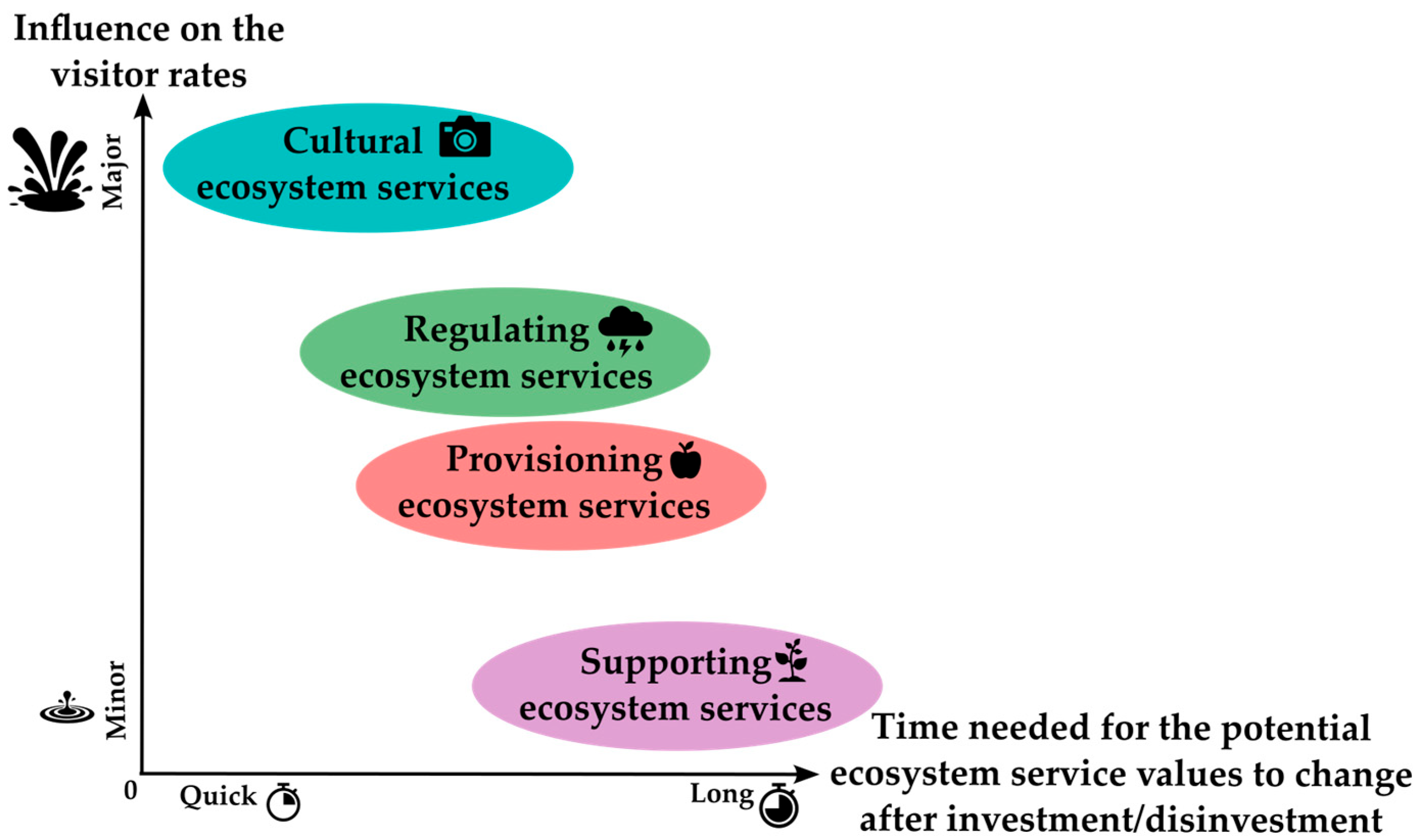
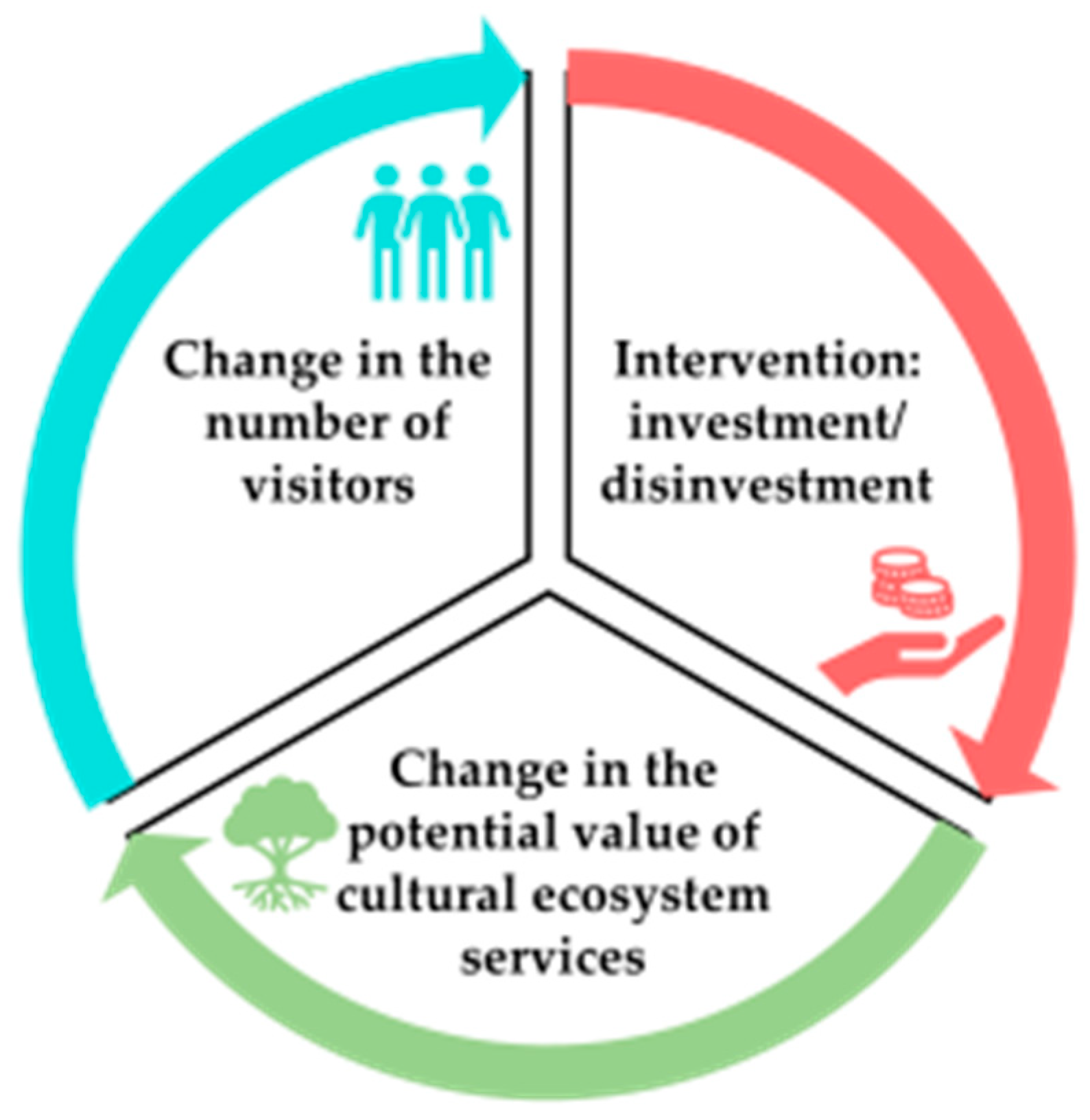
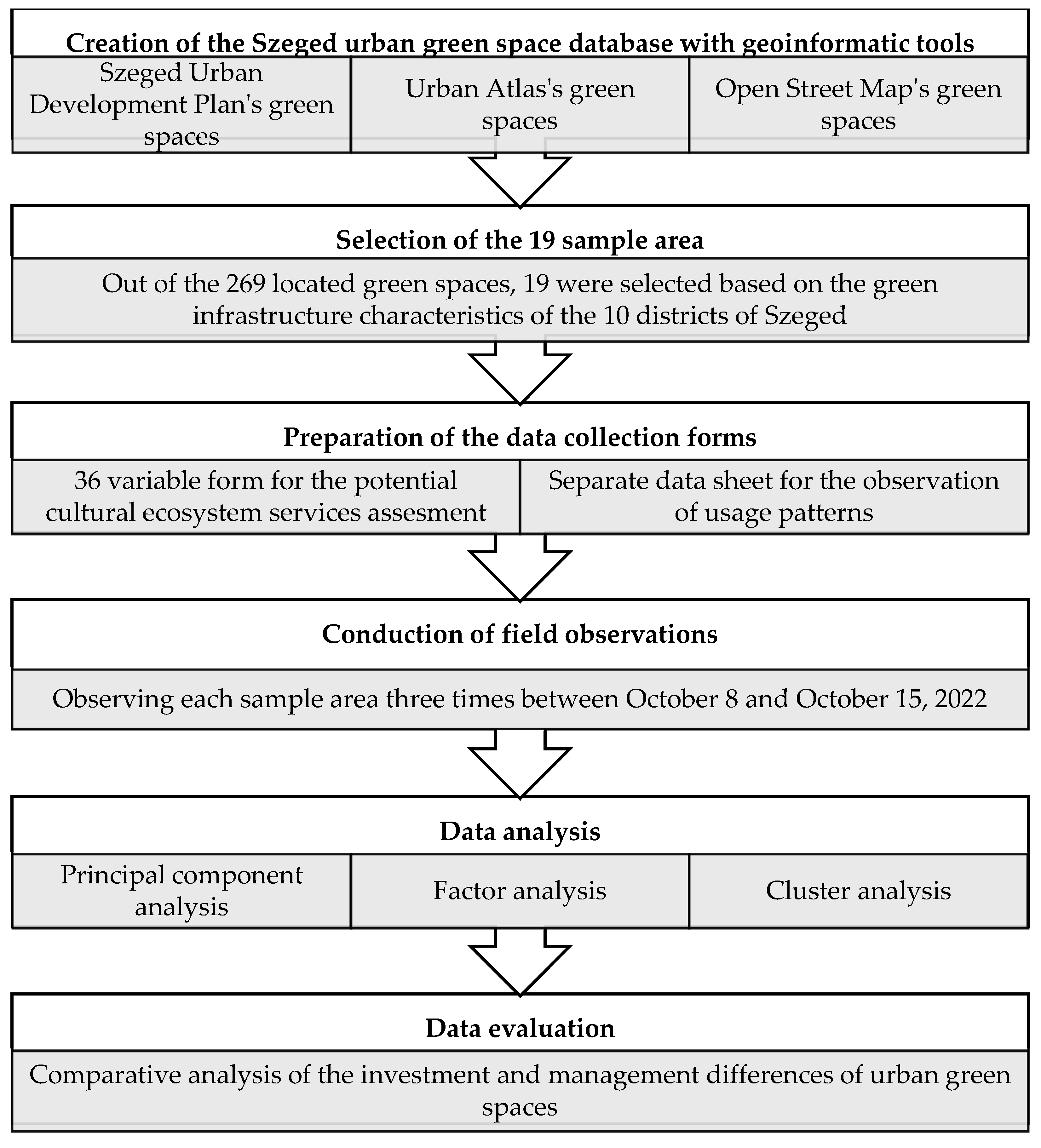
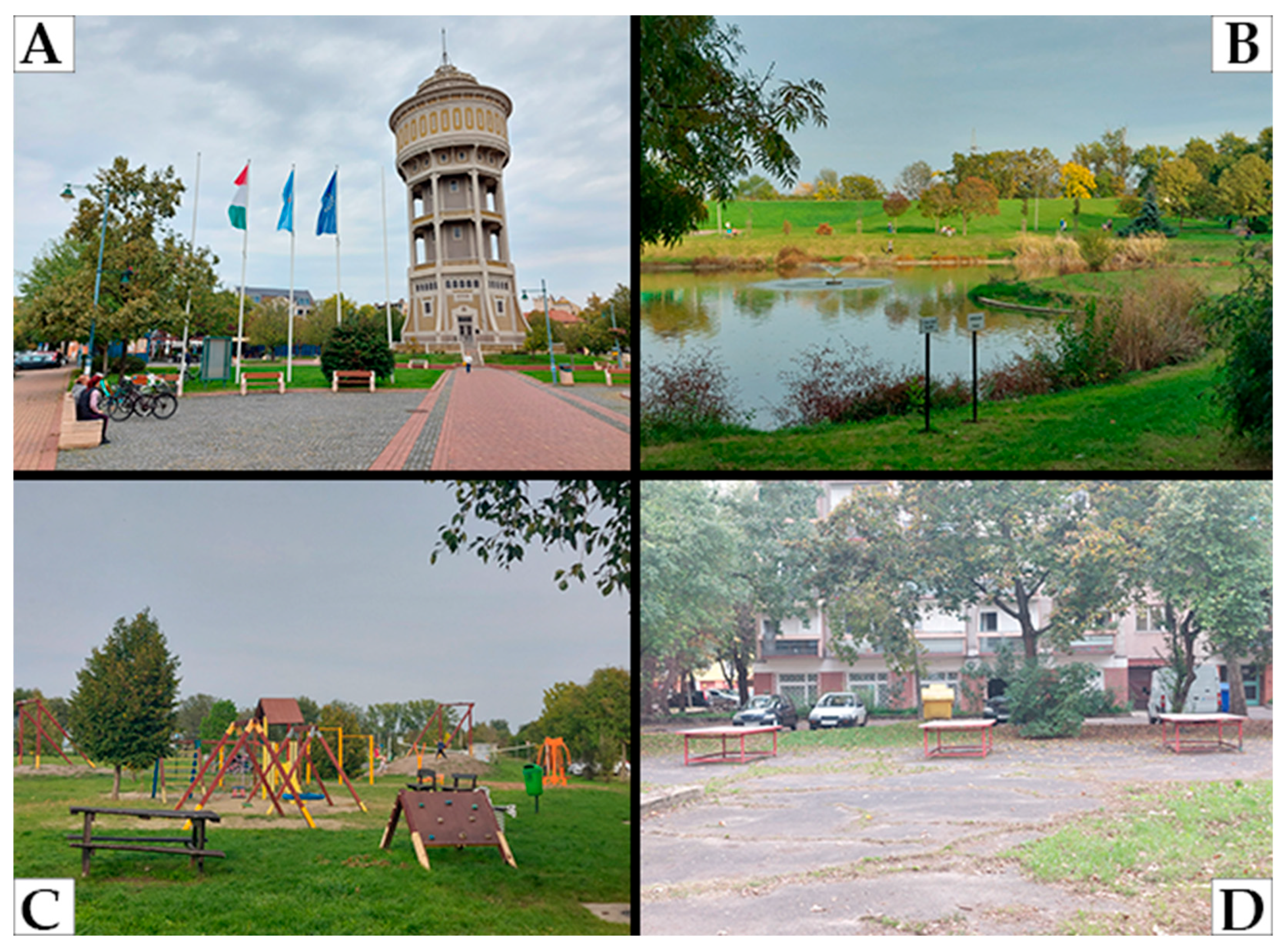
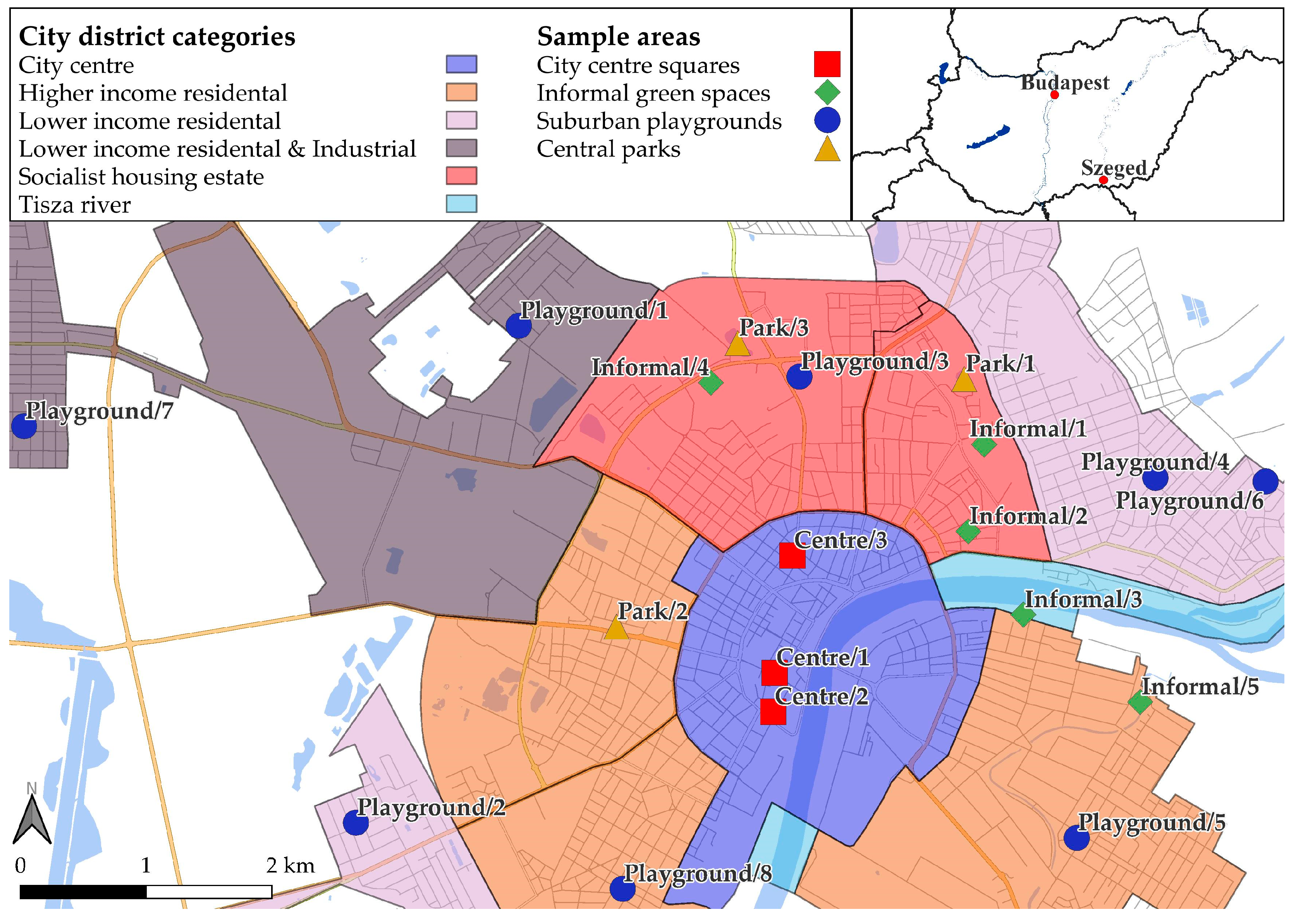
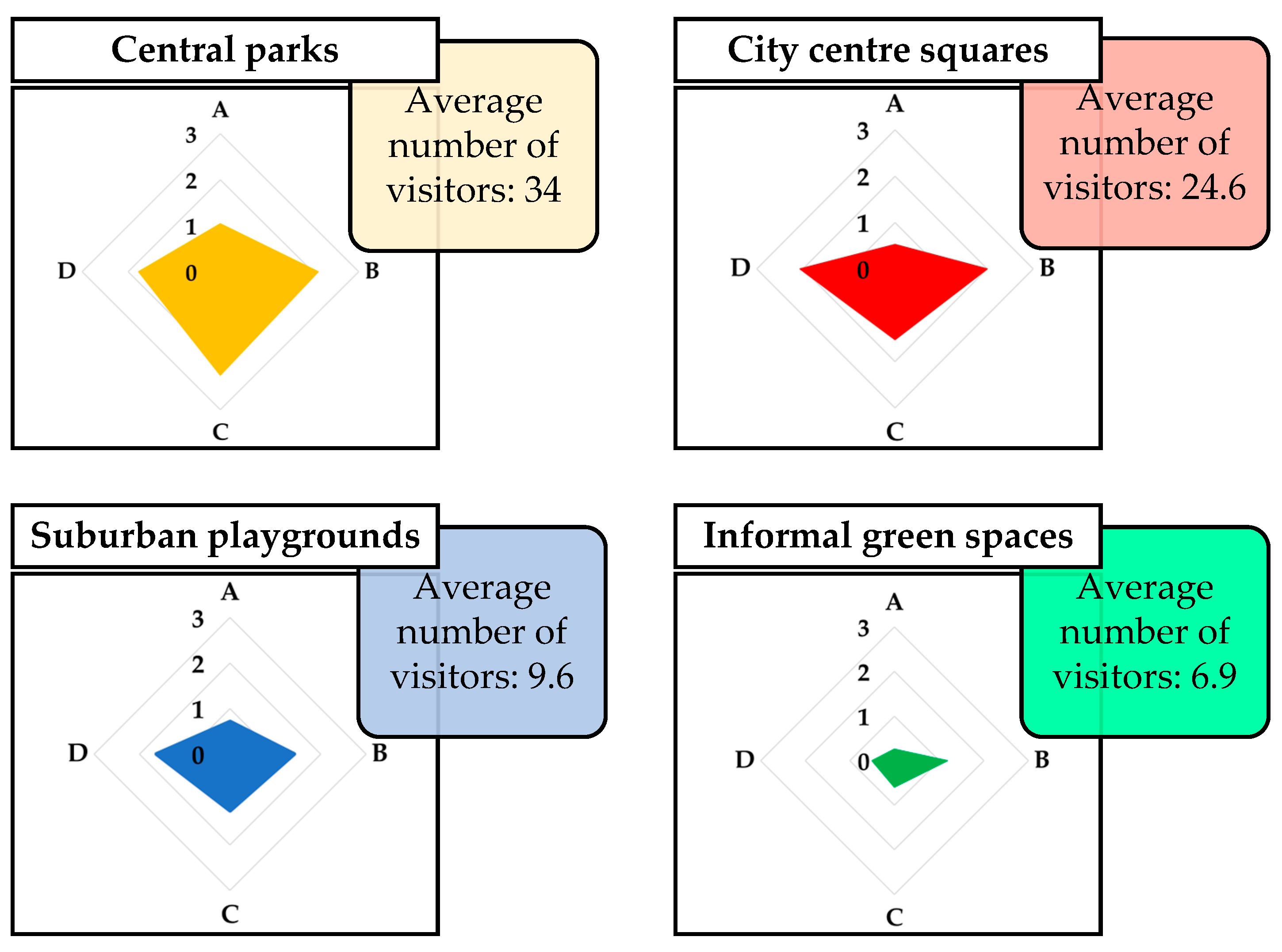
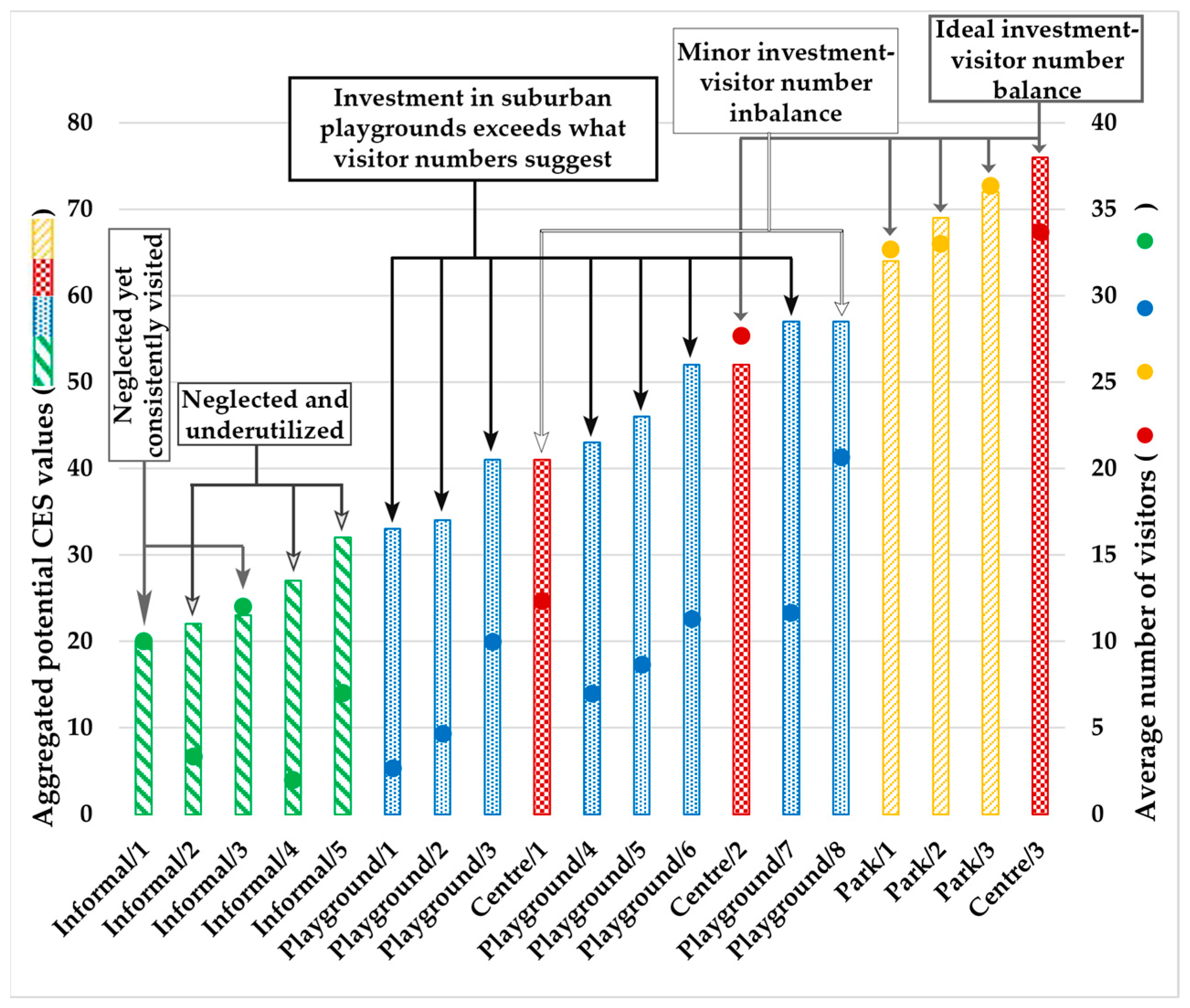
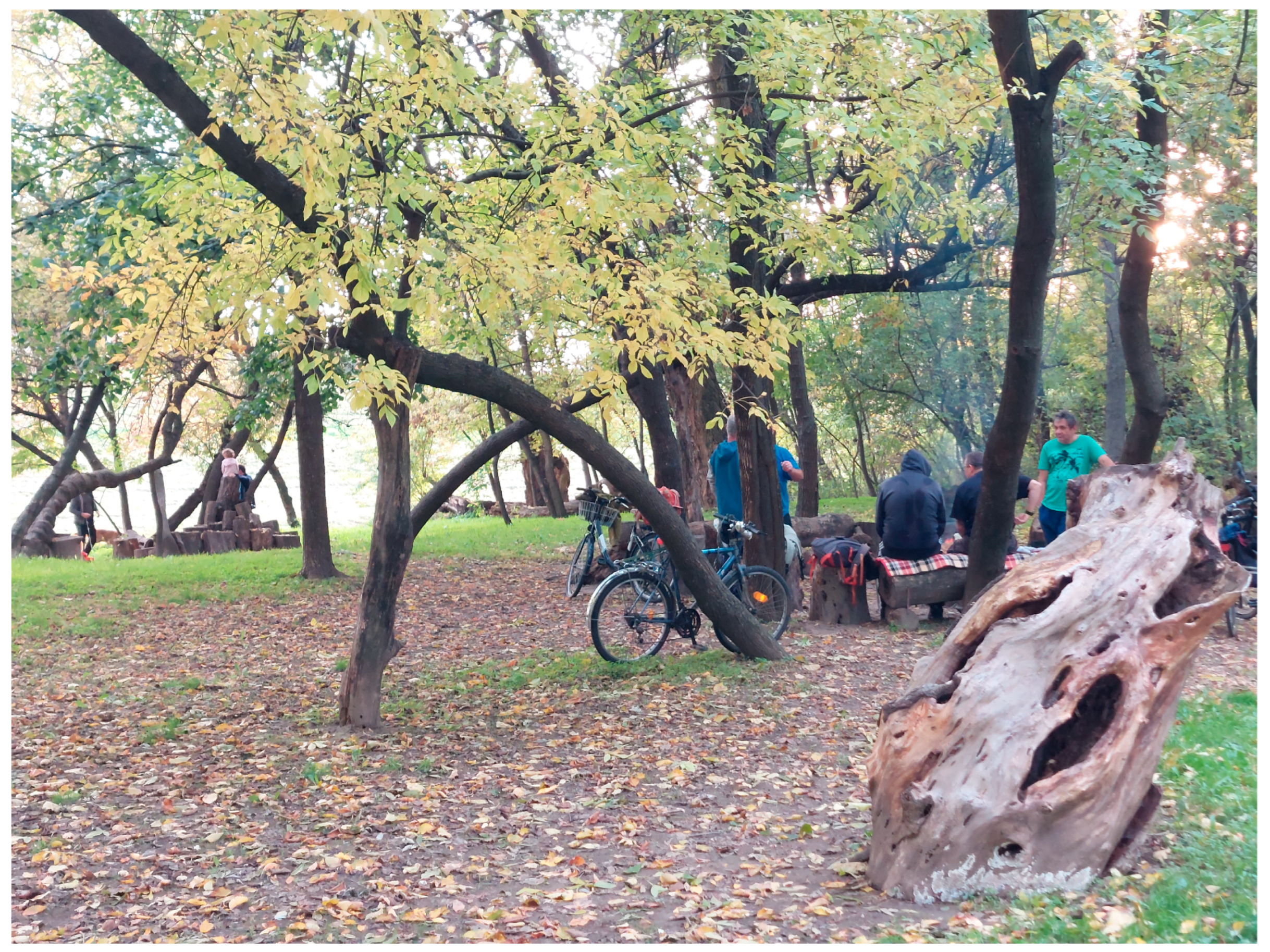
| Data Category | Data Source Type | Data Source |
|---|---|---|
| Urban green space database | Secondary | Szeged Urban Development Plan Urban Atlas Open Street Map |
| Green spaces’ potential cultural ecosystem values | Primary | Field observations |
| Green spaces’ usage patterns | Primary | Field observations |
| Sample Areas’ Code Name | Activities Performed | Environmental Quality | Facilities | Security | Aggregated Potential CES Values | Average Number of Visitors |
| Informal/1 | 0.14 | 0.64 | 0.64 | 0.83 | 20 | 10.00 |
| Informal/2 | 0.00 | 1.09 | 0.50 | 0.67 | 22 | 3.33 |
| Informal/3 | 0.43 | 1.45 | 0.33 | 0.00 | 23 | 12.00 |
| Informal/4 | 0.29 | 0.82 | 1.00 | 0.67 | 27 | 2.00 |
| Informal/5 | 0.43 | 1.91 | 0.50 | 0.33 | 32 | 7.00 |
| Playground/1 | 0.43 | 1.36 | 0.67 | 1.17 | 33 | 2.67 |
| Playground/2 | 0.29 | 1.00 | 0.92 | 1.67 | 34 | 4.67 |
| Playground/3 | 0.00 | 1.55 | 1.00 | 2.00 | 41 | 10.00 |
| Centre/1 | 0.57 | 1.09 | 1.17 | 1.83 | 41 | 12.33 |
| Playground/4 | 0.43 | 1.36 | 1.25 | 1.67 | 43 | 7.00 |
| Playground/5 | 0.14 | 2.00 | 1.50 | 0.83 | 46 | 8.67 |
| Playground/6 | 1.71 | 1.45 | 1.33 | 1.33 | 52 | 11.33 |
| Centre/2 | 0.43 | 2.09 | 1.25 | 1.83 | 52 | 27.67 |
| Playground/7 | 0.86 | 1.73 | 1.67 | 2.00 | 57 | 11.67 |
| Playground/8 | 1.29 | 1.36 | 1.50 | 2.50 | 57 | 20.67 |
| Park/1 | 1.29 | 2.09 | 1.92 | 1.50 | 64 | 32.67 |
| Park/2 | 1.00 | 1.91 | 2.58 | 1.67 | 69 | 33.00 |
| Park/3 | 0.86 | 2.36 | 2.25 | 2.17 | 72 | 36.33 |
| Centre/3 | 1.14 | 2.36 | 2.33 | 2.33 | 76 | 33.67 |
| Average | 0.62 | 1.56 | 1.28 | 1.42 | 45.32 | 15.09 |
| Data Category | Distributive Justice | Procedural Justice | Recognitional Justice |
|---|---|---|---|
| Review of the attractiveness of post-socialist cities’ green spaces by Kronenberg et al. (2020) [18] | Urban green spaces are not adjusted to be attractive to the majority of the locals. | Insufficient inclusion of different groups (especially the most vulnerable ones) in the management and planning of urban green spaces. | In neoliberal capitalism, society is more tolerant of injustices, and the actual needs of certain groups are often overlooked. |
| Case study of the cultural ecosystem services of green spaces in Szeged | Discrepancies in facilities, possible activities, and security of green spaces showcase different investment values, which often cannot be justified by the number of visitors. | Districts with upper-class residents have a higher influence on the UGS management and investment decisions of the municipality. | Due to privatization and commercialization, certain groups and activities are becoming undesirable, and hence, overlooking their right to visit attractive urban green spaces. |
Disclaimer/Publisher’s Note: The statements, opinions and data contained in all publications are solely those of the individual author(s) and contributor(s) and not of MDPI and/or the editor(s). MDPI and/or the editor(s) disclaim responsibility for any injury to people or property resulting from any ideas, methods, instructions or products referred to in the content. |
© 2025 by the authors. Licensee MDPI, Basel, Switzerland. This article is an open access article distributed under the terms and conditions of the Creative Commons Attribution (CC BY) license (https://creativecommons.org/licenses/by/4.0/).
Share and Cite
Tráser, N.Z.; Nagy, G.; Boros, L. Uncovering Urban Green Space (Dis)Investment Through Cultural Ecosystem Service Potential: A Case Study of Szeged, Hungary. Land 2025, 14, 1701. https://doi.org/10.3390/land14091701
Tráser NZ, Nagy G, Boros L. Uncovering Urban Green Space (Dis)Investment Through Cultural Ecosystem Service Potential: A Case Study of Szeged, Hungary. Land. 2025; 14(9):1701. https://doi.org/10.3390/land14091701
Chicago/Turabian StyleTráser, Nándor Zoltán, Gyula Nagy, and Lajos Boros. 2025. "Uncovering Urban Green Space (Dis)Investment Through Cultural Ecosystem Service Potential: A Case Study of Szeged, Hungary" Land 14, no. 9: 1701. https://doi.org/10.3390/land14091701
APA StyleTráser, N. Z., Nagy, G., & Boros, L. (2025). Uncovering Urban Green Space (Dis)Investment Through Cultural Ecosystem Service Potential: A Case Study of Szeged, Hungary. Land, 14(9), 1701. https://doi.org/10.3390/land14091701








